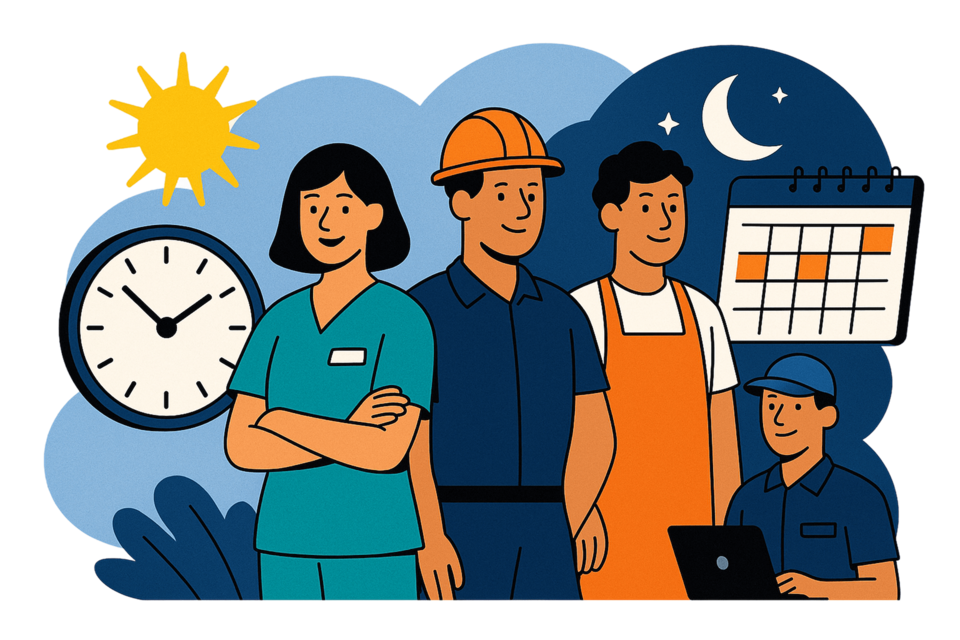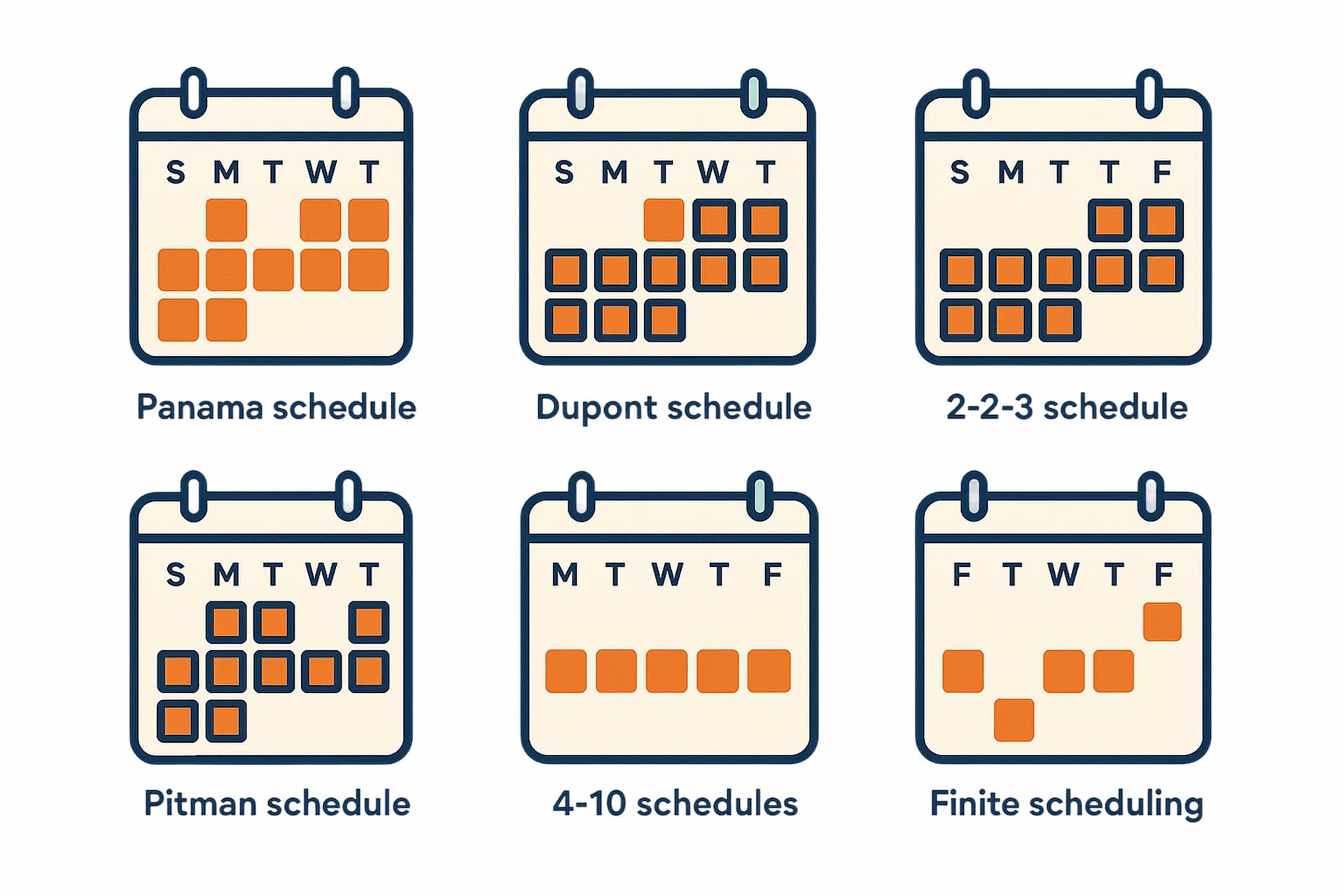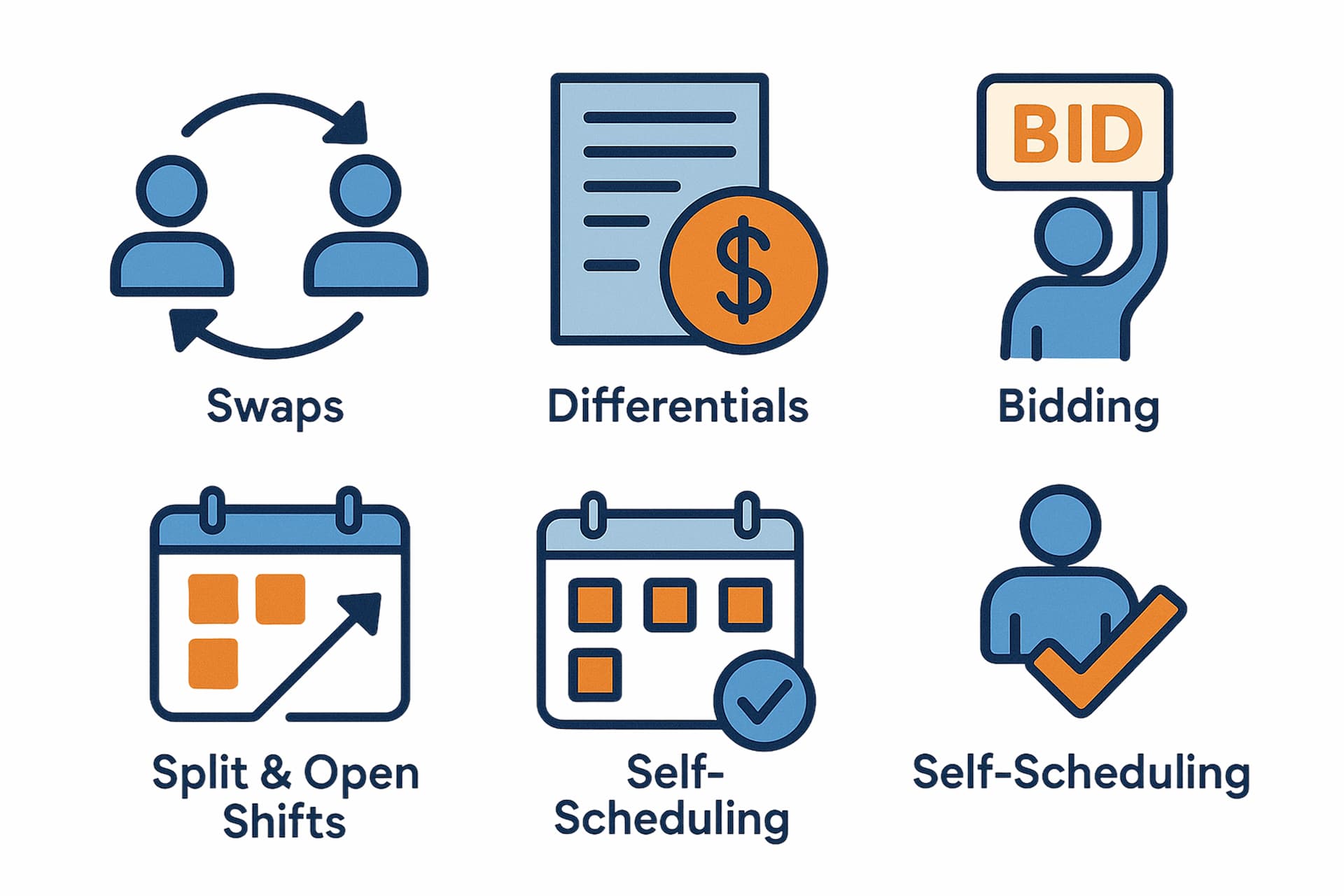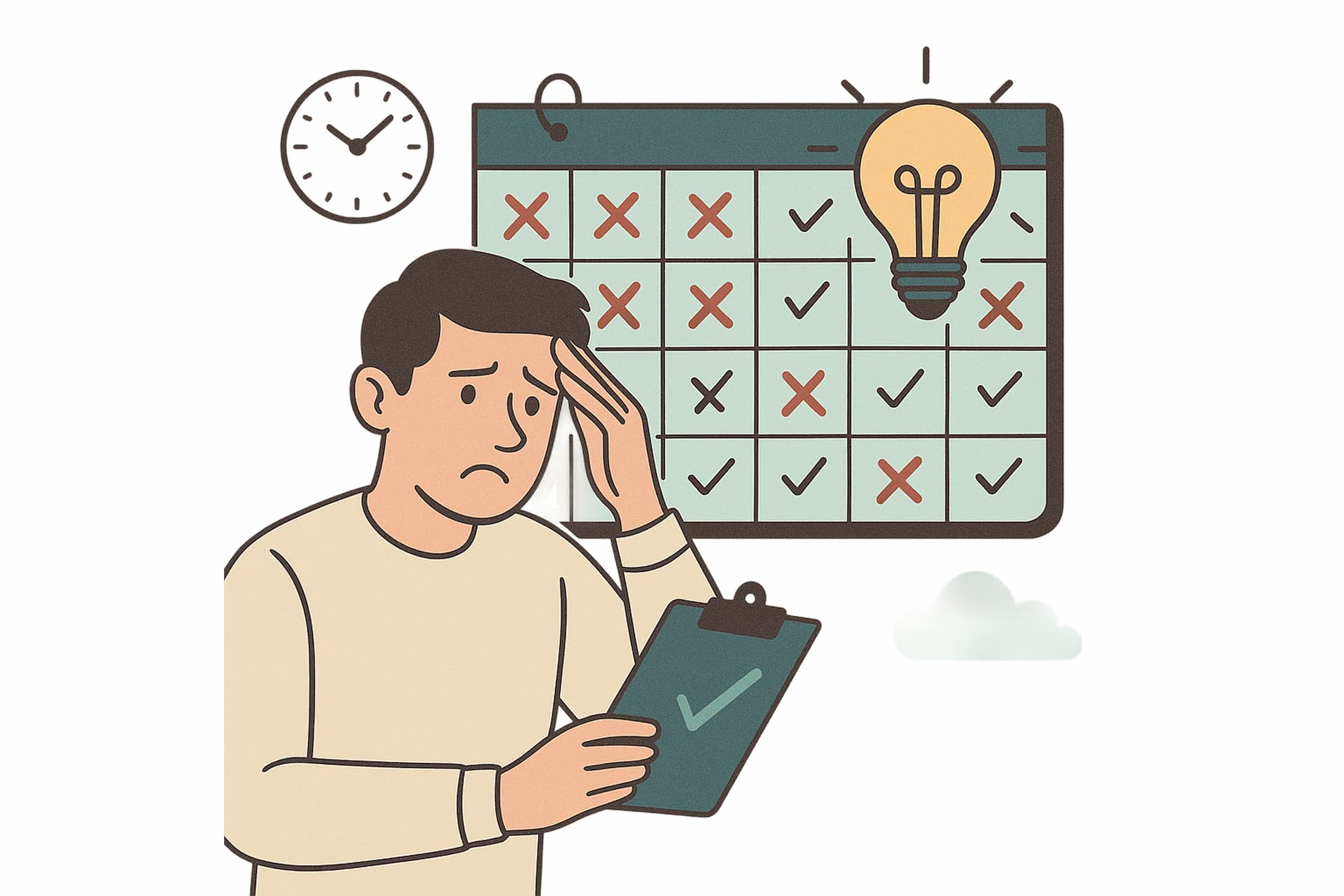What’s inside
- Why shift work matters
- The first shift: familiar and predictable
- The second shift: extending coverage
- The third shift: the overnight workforce
- Swing shifts: bridging day and night
- NOC shifts: specialized overnight monitoring
- Rotating shifts: fairness versus stability
- Benefits and drawbacks of shift work
- Where shift work is essential
- Protecting health and safety
- Managing shifts effectively
- Conclusion
Why shift work matters
More than 20% of the global workforce today works in some form of shifts. Without them, hospitals would shut down at night, airports would close, and e-commerce packages would never arrive on time. Shift work is not new: railroads in the 19th century already used rotating crews to keep trains moving 24/7, and factories during World War II introduced strict “three-shift” systems to maximize production.
For employees, shifts affect not just work hours but their health, family life, and even social identity-night workers often call themselves “the other 9 to 5.” For employers, designing the right shift structure is a matter of safety, efficiency, and competitiveness.
The first shift: familiar and predictable

The first shift, usually 7 a.m. to 3 p.m. or 8 a.m. to 4 p.m., is the most traditional work period. It aligns with schools, banks, and public services, making life logistically easier. For employees, this schedule supports healthy sleep cycles and regular family dinners.
Example: Retail stores like Target or Tesco rely heavily on first-shift workers to handle morning deliveries and daytime customer traffic. In hospitals, first-shift nurses manage rounds and coordinate with doctors.
Interesting fact: A Stanford study showed that first-shift workers report the highest levels of social satisfaction compared to other shifts, since their hours align with the majority of society
The second shift: extending coverage

Second shifts often run from 3 p.m. to 11 p.m. They are popular in manufacturing, hospitality, and logistics. Workers may drop kids at school, rest during the day, and head to work in the afternoon-making it attractive for parents or students.
Example: Many Amazon warehouses rely on second shifts to handle evening surge orders, ensuring same-day or next-day delivery. Restaurants and hotels schedule evening staff to cover dinner rushes, events, and check-ins.
Interesting fact: The term “swing shift” originally comes from U.S. steel factories in the 1940s, where workers “swung” between day and night crews to keep furnaces running nonstop.
For a deeper dive into this schedule, check our complete guide to 2nd shift hours.
The third shift: the overnight workforce

The so-called graveyard shift covers midnight until morning, often 11 p.m. to 7 a.m. It is indispensable for hospitals, emergency services, and IT operations. Night workers often receive extra pay (“shift differentials”) as compensation for the toll it takes on health.
Example: In aviation, air traffic controllers and ground crews at major airports like Heathrow or JFK work overnight to guide cargo flights and prepare runways for the morning rush. IT support teams for global platforms like Netflix or Amazon Web Services monitor systems during the night to prevent downtime.
Interesting fact: Studies show night-shift workers are 30% more likely to suffer from metabolic disorders. NASA research on astronauts has even been applied to helping night nurses manage circadian disruption with special lighting.
Want to learn more? Explore our third shift hours guide.
Swing shifts: bridging day and night

Swing shifts usually cover 4 p.m. to midnight. They are designed to handle peak demand in late afternoon and evening without requiring full night coverage. Employees often like them because mornings are free, but late nights can be socially isolating.
Example: Casinos in Las Vegas schedule swing shifts to cover the busiest gaming hours between afternoon and midnight. Call centers often use swing schedules to handle customer requests from overlapping time zones (for example, U.S. and Europe).
Interesting fact: In the hospitality industry, swing shifts are sometimes called the “money shift” because tips are highest during peak dinner service and evening entertainment.
Curious about how swing schedules developed? Read our article on swing shifts.
NOC shifts: specialized overnight monitoring

NOC, short for Network Operations Center, refers to overnight shifts where teams monitor systems, networks, or security. Unlike regular night shifts, NOC jobs are highly technical and focused on alerts, incidents, and escalation protocols.
Example: Telecom providers like AT&T or Vodafone run 24/7 NOCs to ensure internet and mobile networks never go down. In healthcare, sleep labs use NOC technicians to observe patients overnight.
Interesting fact: Google’s massive global infrastructure is monitored by NOC teams in multiple time zones, ensuring that if a server fails in one region at 3 a.m., someone is awake to fix it immediately.
To better understand the NOC role, visit our guide on NOC shifts.
Rotating shifts: fairness versus stability

Rotating shifts cycle workers through days, evenings, and nights-spreading the burden of unpopular hours. Schedules can follow weekly or biweekly rotations, or complex formats like the 2–2–3 “Panama schedule” (two days on, two off, three on, then switch).
Example: Firefighters and police departments frequently use rotating shifts to balance coverage while giving officers fair rest periods. In manufacturing plants, rotating teams keep machines running 24/7 without overworking any single group.
Interesting fact: Research shows forward-rotating schedules (day → evening → night) are less damaging to health than backward rotations, because they follow the body’s natural tendency to fall asleep later rather than earlier.
For an overview of rotation models, see our introduction to rotating shifts.
Benefits and drawbacks of shift work
For businesses, shift work means continuous production, higher customer satisfaction, and resilience in critical industries. For employees, it offers flexibility-students may prefer evenings, parents may prefer nights.
But the downsides are significant: disrupted sleep, increased health risks, and social challenges. In fact, the World Health Organization has classified night-shift work as a “probable carcinogen” due to its long-term effects on circadian rhythm.
Where shift work is essential
- Healthcare / Medical: emergency rooms, intensive care, overnight monitoring
- Logistics: overnight trucking, ports, e-commerce warehouses
- Hospitality (Hotels / Resorts): guest services, events, 24/7 front desk
- Food & Beverage (Restaurants / Cafes / Bars): dinner rushes, late-night service, catering
- Security: police, firefighters, paramedics, patrols
- Retail: evening shopping, peak weekend hours
- Manufacturing: production lines, maintenance during off-peak hours
- Call Centers / Customer Support: 24/7 customer requests and international coverage
- Transportation: airports, trucking, late-night deliveries
- Caregivers / Assisted Living: round-the-clock patient and resident support
Protecting health and safety
Companies that rely on shift work must actively reduce its health impact. Best practices include forward rotations, guaranteed rest periods, bright task lighting, and transport options after night shifts. Some firms even offer nap pods or “recovery rooms” to help employees fight fatigue.
Example: Toyota plants in Japan rotate workers carefully to avoid burnout, while Scandinavian hospitals experiment with four-day compressed shifts to improve nurse wellbeing.
Managing shifts effectively
Running a shift-based workforce isn’t just about filling gaps-it’s about balancing efficiency with humanity. That means forecasting demand, publishing schedules early, allowing swaps, and tracking attendance accurately. Data-driven scheduling helps identify when error rates spike (often at 4 a.m.) and allows managers to adjust coverage before problems occur.
Software like Shifts by Everhour gives managers the ability to plan rosters, manage time clocks, and ensure compliance-while giving employees more transparency and control.
Conclusion
Shift work has been with us for over a century, and it’s not going away. From hospital wards to global cloud networks, it keeps the world running 24/7. But it comes with a human cost if not managed well. The most successful organizations are those that treat shift scheduling as both an operational science and a people challenge-balancing coverage with health, fairness, and long-term sustainability.
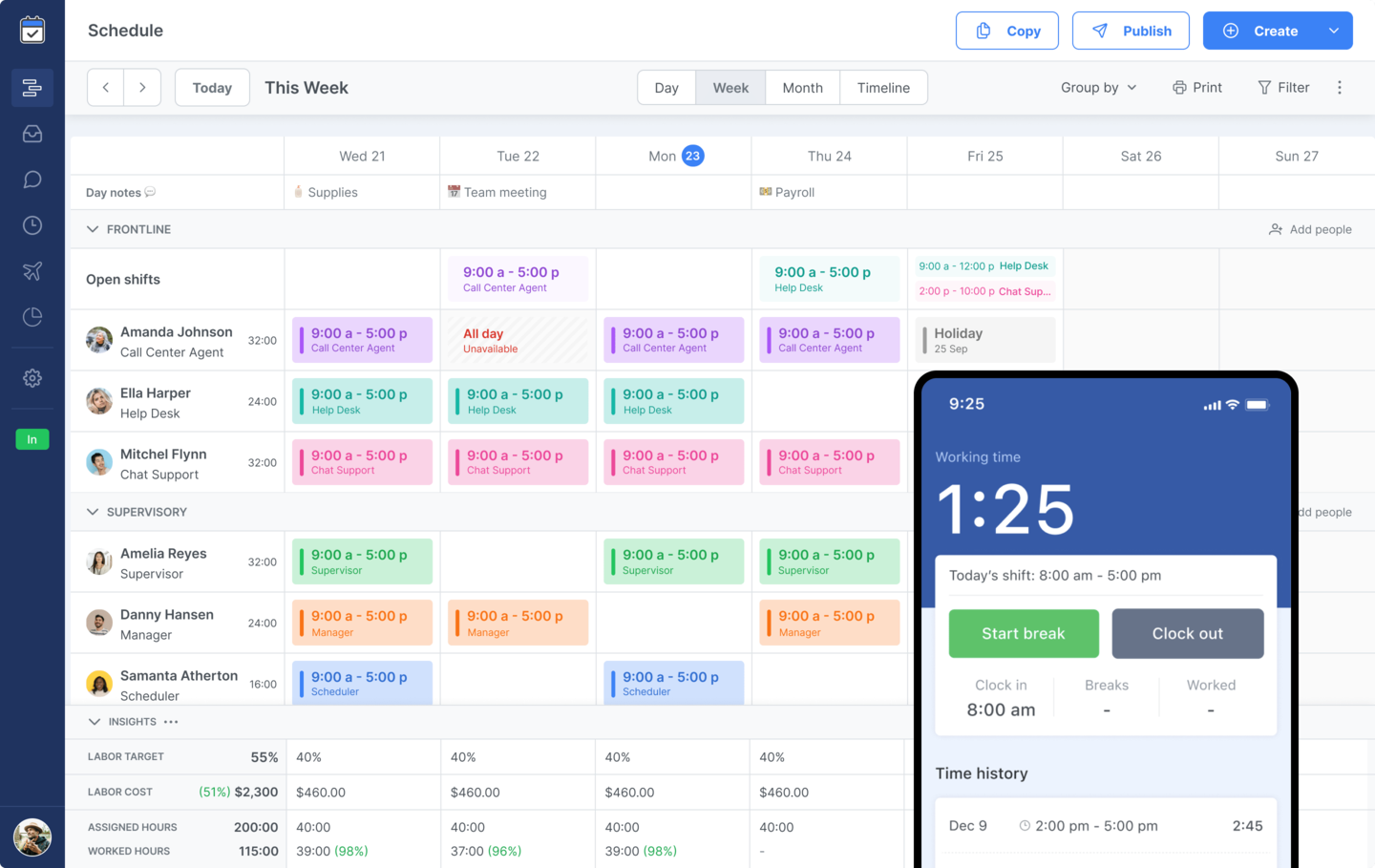
Want to simplify shift management? Try Shifts by Everhour and see how easy it is to build smarter rosters, reduce burnout, and keep your business moving day and night.
